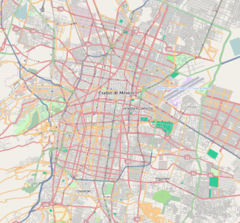Popotla is a station on Line 2 of the Mexico City Metro system. It is located in the Colonia Popotla neighborhood of the Miguel Hidalgo borough of Mexico City, northwest of the city center, on the Calzada México-Tacuba.[2][3] In 2019 the station had an average ridership of 10,000 passengers per day, making it the least used station on Line 2.[4]
| STC rapid transit | |||||||||||
 Station entrance sign, 22 December 2006 | |||||||||||
| General information | |||||||||||
| Location | Calzada México-Tacuba Popotla, Miguel Hidalgo Mexico City Mexico | ||||||||||
| Coordinates | 19°27′08″N 99°10′29″W / 19.452147°N 99.1747°W | ||||||||||
| Operated by | Sistema de Transporte Colectivo (STC) | ||||||||||
| Line(s) | |||||||||||
| Platforms | 2 side platform | ||||||||||
| Tracks | 2 | ||||||||||
| Construction | |||||||||||
| Structure type | Underground | ||||||||||
| Other information | |||||||||||
| Status | In service | ||||||||||
| History | |||||||||||
| Opened | 14 September 1970 | ||||||||||
| Passengers | |||||||||||
| 2023 | 2,804,236[1] | ||||||||||
| Rank | 136/195[1] | ||||||||||
| Services | |||||||||||
| |||||||||||
| |||||||||||
Name and pictogram
editThe name of the station comes from the neighborhood it serves: Popotla. The logo depicts an ahuehuete tree, referring to the Árbol de la Noche Triste – the "tree of the sad night" – where Spanish conquistador Hernán Cortés stopped his retreat from Tenochtitlán and cried after being defeated by Cuitláhuac in the Battle of Noche Triste.[2][3] The actual tree survived until the 20th century, when it was destroyed by a fire. There is a commemorative plaque on the site where the tree used to be.
General information
editThe station was opened on 14 September 1970 as part of the second stretch of Line 2, from Pino Suárez to Tacuba.[5] Metro Popotla serves the neighborhood of the same name.
From 23 April to 24 June 2020, the station was temporarily closed due to the COVID-19 pandemic in Mexico.[6][7]
Ridership
edit| Annual passenger ridership | |||||
|---|---|---|---|---|---|
| Year | Ridership | Average daily | Rank | % change | Ref. |
| 2023 | 2,804,236 | 7,682 | 136/195 | +12.85% | [1] |
| 2022 | 2,484,958 | 6,808 | 140/195 | +78.75% | [1] |
| 2021 | 1,390,202 | 3,808 | 159/195 | −3.38% | [8] |
| 2020 | 1,438,795 | 3,931 | 172/195 | −60.58% | [9] |
| 2019 | 3,650,212 | 10,000 | 154/195 | −0.80% | [4] |
| 2018 | 3,679,693 | 10,081 | 153/195 | +0.20% | [10] |
| 2017 | 3,672,167 | 10,060 | 150/195 | −2.49% | [11] |
| 2016 | 3,766,005 | 10,289 | 147/195 | −2.36% | [12] |
| 2015 | 3,857,093 | 10,567 | 135/195 | +3.41% | [13] |
| 2014 | 3,729,954 | 10,219 | 136/195 | −5.92% | [14] |
Nearby
edit- Universidad del Ejército y Fuerza Aérea, university of the Mexican Army and the Air Force
Entrances
editSee also
editReferences
edit- ^ a b c d "Afluencia de estación por línea 2023" [Station traffic per line 2023] (in Spanish). Sistema Transporte Colectivo Metro. 2024. Archived from the original on 27 January 2024. Retrieved 24 January 2024.
- ^ a b "Popotla" (in Spanish). Archived from the original on 31 January 2012. Retrieved 16 August 2011.
- ^ a b Archambault, Richard. "Popotla » Mexico City Metro System". Retrieved 16 August 2011.
- ^ a b "Afluencia de estación por línea 2019" [Station traffic per line 2019] (in Spanish). Sistema Transporte Colectivo Metro. 2020. Archived from the original on 8 April 2020. Retrieved 3 May 2020.
- ^ Monroy, Marco. Schwandl, Robert (ed.). "Opening Dates for Mexico City's Subway". Retrieved 15 August 2011.
- ^ "Cierre temporal de estaciones" (PDF) (in Spanish). Metro CDMX. Retrieved 25 April 2020.
- ^ Hernández, Eduardo (13 June 2020). "Coronavirus. Este es el plan para reabrir estaciones del Metro, Metrobús y Tren ligero". El Universal (in Spanish). Retrieved 15 June 2020.
- ^ "Afluencia de estación por línea 2021" [Station traffic per line 2021] (in Spanish). Sistema Transporte Colectivo Metro. 2022. Archived from the original on 7 March 2022. Retrieved 7 March 2022.
- ^ "Afluencia de estación por línea 2020" [Station traffic per line 2020] (in Spanish). Sistema Transporte Colectivo Metro. 2021. Archived from the original on 21 June 2021. Retrieved 21 June 2021.
- ^ "Afluencia de estación por línea 2018" [Station traffic per line 2018] (in Spanish). Sistema Transporte Colectivo Metro. 2019. Archived from the original on 6 June 2019. Retrieved 7 April 2020.
- ^ "Afluencia de estación por línea 2017" [Station traffic per line 2017] (in Spanish). Sistema Transporte Colectivo Metro. 2019. Archived from the original on 3 May 2020. Retrieved 3 May 2020.
- ^ "Afluencia de estación por línea 2016" [Station traffic per line 2016] (in Spanish). Sistema Transporte Colectivo Metro. 2017. Archived from the original on 3 May 2020. Retrieved 3 May 2020.
- ^ "Afluencia de estación por línea 2015" [Station traffic per line 2015] (in Spanish). Sistema Transporte Colectivo Metro. 2016. Archived from the original on 3 May 2020. Retrieved 6 May 2020.
- ^ "Afluencia de estación por línea 2014" [Station traffic per line 2014] (in Spanish). Sistema Transporte Colectivo Metro. 2015. Archived from the original on 3 May 2020. Retrieved 6 May 2020.

